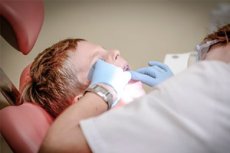Medical expert of the article
New publications
Oral examination
Last reviewed: 05.07.2025

All iLive content is medically reviewed or fact checked to ensure as much factual accuracy as possible.
We have strict sourcing guidelines and only link to reputable media sites, academic research institutions and, whenever possible, medically peer reviewed studies. Note that the numbers in parentheses ([1], [2], etc.) are clickable links to these studies.
If you feel that any of our content is inaccurate, out-of-date, or otherwise questionable, please select it and press Ctrl + Enter.

Examination of the oral cavity includes examination of the lips, teeth, gums, tongue, palate, tonsils, mucous membrane of the cheeks and pharynx.
Teeth and gums
The number of teeth largely determines the efficiency of the chewing process, which may not be thorough enough if there are no molars. Discoloration of teeth is often associated with smoking and poor hygiene. Dental caries is common, requiring treatment by a dentist.
Sometimes progressive dental caries is combined with other signs of the so-called dry syndrome. A characteristic manifestation of gum pathology is pyorrhea ( periodontosis ), accompanied by bleeding and the appearance of a narrow band of inflammation of the free edge of the gums. As the process progresses, pus accumulates between the teeth and along the edge of the gums, creating conditions for the occurrence of transient bacteremia (green streptococcus), which must be taken into account in patients with rheumatism.
Language
Tongue movements are important for assessing some disorders of the central nervous system. Attention is paid to the symmetry and size of the tongue, its mobility. Enlargement of the tongue (c) occurs in some diseases, such as amyloidosis. The color of the tongue sometimes depends on the characteristics of the food. It is usually pink or red with papillae on its surface. The tongue may be coated with a coating in digestive disorders. Special attention should be paid to the appearance of a bright red color ("raspberry" tongue) and smoothness of the mucous membrane of the tongue ("varnished" tongue) - "Gunter's tongue", which is very typical for a number of vitamin deficiencies, but especially for vitamin B 12 deficiency.
Tonsils
The tonsils are lymphoid formations located between the anterior and posterior arches at the transition of the oral cavity into the pharynx. They reach their maximum size between the ages of 8 and 12 and then undergo involution. They may enlarge and become inflamed during exacerbation of streptococcal infection, infectious mononucleosis, and diphtheria.
The condition of the salivary glands is often judged by the sensation of dryness in the mouth (xerostomia), which indicates their hypofunction. Xerostomia in combination with xerophthalmia and dry keratoconjunctivitis (the result of impaired tear production) make up the so-called dry syndrome, which can affect the joints, lungs, pancreas and other organs. Sometimes an increase in the parotid glands is detected. Mumps is observed in sarcoidosis, tumor damage, alcoholism, and most often it has an infectious origin ("mumps").
Changes (ulcerations) of the oral mucosa occur with aphthous stomatitis, and patients experience very unpleasant sensations. Stomatitis with ulcers can also be observed in chronic tumor diseases, such as acute leukemia, as well as agranulocytosis.Candidal stomatitis has a characteristic appearance, which is observed during long-term intensive treatment with antibiotics and immunosuppressants. A number of acute infections are accompanied by the appearance of peculiar rashes on the oral mucosa, which can be used as a guide for diagnosis (for example, Velsky-Filatov-Koplik spots in patients with measles). Yellowish staining of the mucosa, especially the tongue (hyperbilirubinemia), is possible, in addition, telangiectasias ( Rendu-Osler disease ) occur.
Who to contact?

